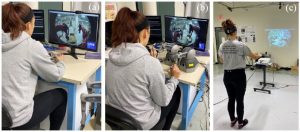Tele-nursing robots provide a safe approach for patient-caring in quarantine areas. For effective nurse-robot collaboration, ergonomic teleoperation interfaces have to be developed that are intuitive and reduce the physical and cognitive workload. We propose a framework to evaluate the control interfaces that help to iteratively develop an intuitive, efficient and ergonomic teleoperation interface. We first present the usage of pre-defined objective and subjective metrics to evaluate three representative designs of contemporary teleoperation interfaces. The results indicate that teleoperation via human motion mapping outperforms the gamepad and stylus interfaces. The trade-off with using motion mapping as a teleoperation interface is the non-trivial physical fatigue. To better understand the impact of heavy physical demand during motion mapping teleoperation, we propose an objective assessment of physical workload in robot teleoperation using electromyography (EMG). We find that physical fatigue happens more in the actions that involve precise manipulation and steady posture maintenance. We further implemented the teleoperation assistance in the form of shared autonomy to eliminate the fatigue-causing component in robot teleoperation via human motion mapping. The experimental results show that the simple autonomous feature can effectively reduce the physical effort while improving the efficiency and accuracy of the teleoperation interface.
Publication
- Tsung-Chi Lin, Achyuthan Unni Krishnan and Zhi Li, “Intuitive, Efficient and Ergonomic Tele-Nursing Robot Interfaces: Design Evaluation and Evolution”, Submitted to ACM Transactions on Human-Robot Interaction (THRI), 2020.


